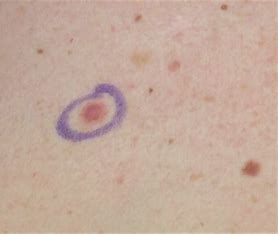Introduction
Melanoma is a type of skin cancer that develops in the cells responsible for producing melanin, the pigment that gives color to the skin, hair, and eyes. It is considered the most serious form of skin cancer because it has the potential to spread (metastasize) to other parts of the body if not detected and treated early. In this article, we will explore the causes, risk factors, symptoms, diagnosis, and treatment options for melanoma.
Understanding Melanoma
Melanoma develops when the pigment-producing cells, called melanocytes, undergo genetic mutations, causing them to multiply rapidly and form malignant tumors. Although melanoma can occur anywhere on the body, it is commonly found on areas exposed to the sun, such as the face, neck, arms, and legs. However, it can also develop in non-sun-exposed areas or even inside the eye.
Causes and Risk Factors
The primary cause of melanoma is believed to be excessive exposure to ultraviolet (UV) radiation, either from sunlight or artificial sources like tanning beds. Other risk factors for melanoma include:
- Fair skin, light hair, and light-colored eyes: People with less melanin in their skin have less natural protection against UV radiation.
- Family history: Having a close relative with melanoma increases the risk of developing the disease.
- Personal history: Individuals who have had melanoma in the past are at a higher risk of developing a new melanoma.
- Numerous or unusual moles: Having many moles or atypical moles (dysplastic nevi) increases the risk of melanoma.
- Weakened immune system: Individuals with a weakened immune system, such as organ transplant recipients or those with certain immune disorders, are at higher risk.
- Severe sunburns: A history of severe sunburns, particularly during childhood, increases the risk of melanoma.
- Age: Melanoma can occur at any age, but the risk increases with age, especially in older adults.
Symptoms and Detection
Melanoma may present as a new spot or a change in an existing mole or freckle. The “ABCDE” rule can help identify potential signs of melanoma:
- Asymmetry: One half of the mole or spot does not match the other half.
- Border irregularity: The edges of the mole are uneven, blurred, or notched.
- Color variations: The mole exhibits different colors or shades, such as brown, black, red, white, or blue.
- Diameter: The size of the mole is larger than 6 millimeters (about the size of a pencil eraser), although melanomas can be smaller.
- Evolution: The mole is changing in size, shape, color, or elevation over time.
It is important to note that not all melanomas follow these characteristics, and some may appear as pink, red, or even normal skin.
Diagnosis and Treatment
If melanoma is suspected, a healthcare professional will perform a thorough examination and may recommend further tests, including:
- Skin biopsy: A small sample of the suspicious area is removed and sent to a laboratory for examination under a microscope to determine if it is cancerous.
- Sentinel lymph node biopsy: In cases where melanoma has a higher likelihood of spreading, a biopsy of the nearby lymph nodes may be recommended to assess whether the cancer has spread.
Treatment options for melanoma depend on the stage and location of the cancer. They may include:
- Surgery: The primary treatment for melanoma involves surgically removing the cancerous tumor and a surrounding margin of healthy tissue. In some cases, nearby lymph nodes may also be removed.
- Immunotherapy: This treatment uses medications that stimulate the immune system to recognize and attack cancer cells.
- Targeted therapy: Certain medications can target specific genetic mutations in melanoma cells to disrupt their growth and survival.
- Radiation therapy: High-energy X-rays are used to kill cancer cells or relieve symptoms in cases where surgery is not possible.
- Chemotherapy: Although less common for melanoma, chemotherapy may be used in advanced cases or when other treatments have not been successful.
Prevention and Early Detection
Taking preventive measures can significantly reduce the risk of melanoma:
- Protect your skin from UV radiation: Limit sun exposure, especially during peak hours, wear protective clothing, use broad-spectrum sunscreen with a high SPF, and avoid tanning beds.
- Perform regular self-examinations: Check your skin regularly for any changes in moles, freckles, or new spots, and seek medical attention if you notice anything suspicious.
- Get regular skin exams: Schedule routine skin examinations with a dermatologist, especially if you have a higher risk of developing melanoma.
Conclusion
Melanoma is a serious form of skin cancer that arises from melanocytes, the cells responsible for skin pigmentation. It can occur anywhere on the body and is primarily caused by excessive exposure to UV radiation. Early detection and treatment are crucial for successful outcomes. By understanding the risk factors, recognizing the symptoms, and practicing preventive measures, such as sun protection and regular skin examinations, individuals can reduce their risk of developing melanoma and improve the chances of early detection. It is essential to consult with healthcare professionals for proper diagnosis, treatment, and ongoing monitoring for individuals at risk or diagnosed with melanoma.

